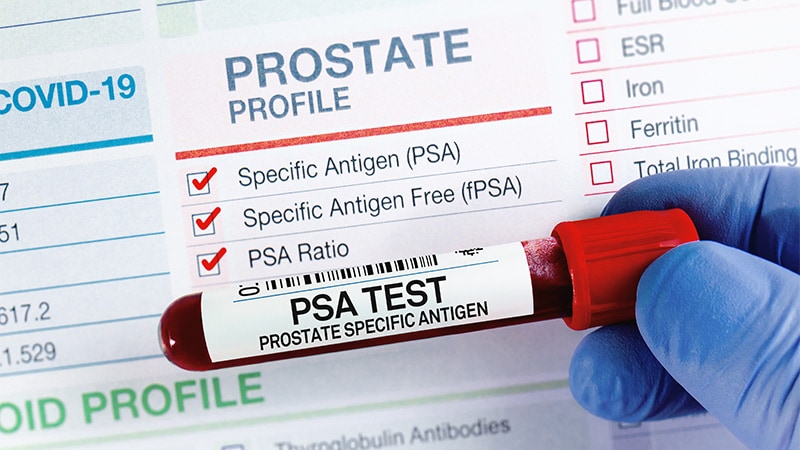CHICAGO — Prostate-specific antigen (PSA) levels could help guide treatment decisions for patients with metastatic hormone-sensitive prostate cancer, according to real-world findings from the IRONMAN study.
Specifically, an undetectable PSA nadir — defined as PSA level < 0.2 ng/mL — predicted a good prognosis and a PSA level ≥ 0.2 ng/mL predicted poor prognosis among patients receiving androgen deprivation therapy (ADT) or androgen receptor pathway inhibitor (ARPI) therapy for 6-12 months, according to Michael Ong, MD, who presented the findings at the 2025 American Society of Clinical Oncology annual meeting.
In other words, this real-world study found that absolute PSA at 6 and 12 months is prognostic in this patient population, said Ong, a medical oncologist at Ottawa Hospital Research Institute, Canada.
Patients with a poor prognosis could then be considered for clinical trials offering therapy escalation, whereas those with a better prognosis — particularly those with PSA < 0.1 ng/mL — could be considered for de-escalation, said Ong.
Ong explained that prior phase 3 studies have demonstrated that PSA > 0.2 ng/mL is associated with poor prognosis in patients receiving ADT and ARPI. However, data in real-world settings remain limited. Some patients with rapid PSA decline never progress, whereas others develop early resistance despite intensive therapy, he explained.
The IRONMAN study set out to answer two main questions: When should PSA cutoffs be interpreted for prognostic significance? And how may PSA cutoffs differ in real-world patients?
To this end, Ong and his colleagues included 1219 patients from the prospective IRONMAN cohort with metastatic hormone-sensitive prostate cancer who had received ADT and ARPI therapy, with or without docetaxel, and had PSA data available. PSA was stratified into three groups: ≥ 0.2 ng/mL, 0.10-0.19 ng/mL, and < 0.10 ng/mL.
The research team constructed a 12-month landmark population to assess conditional overall survival (OS) and progression-free survival (PFS) at 6 and 12 months across each PSA level. The 12-month analysis was the primary study outcome.
Patients were a median age of 70 years, 58% had Gleason score of 8-10, and 75% had de novo metastatic disease. Overall, most (74%) were White and just over half were enrolled from centers outside US or Canada. ARPI agents included abiraterone acetate (44%), apalutamide (21%), enzalutamide (22%), or darolutamide (13%), and 12% of patients received docetaxel in addition to doublet therapy with ADT plus ARPI.
PSA levels shifted across the two time points. At 6 months, 52% of patients had a PSA < 0.2 ng/mL, whereas 48% had a PSA level ≥ 0.2 ng/mL. At 12 months, 68% had PSA levels < 0.2 ng/mL and 32% had levels ≥ 0.2 ng/mL.
Both the 6- and 12-month landmark analyses showed that PSA ≥ 0.2 ng/mL was associated with worse conditional OS and PFS compared with PSA < 0.2 ng/mL.
Ong broke down conditional OS and PFS at 12 months — the primary study outcome —by absolute PSA levels.
| Absolute PSA | 3-year overall survival | 3-year progression-free survival | OS mortality risk (adjusted hazard ratio) |
| ≥ 0.2 ng/mL | 45% | 41% | 4.85 (3.36-7.01) |
| 0.10-0.19 ng/mL | 79% | 62% | 1.34 (0.82-2.20) |
| < 0.1 ng/mL | 84% | 80% | Reference |
After adjustment for confounders, PSA ≥ 0.2 ng/mL was associated with an almost fivefold higher risk for death at 12 months (adjusted hazard ratio, 4.85).
Ong noted that PSA was prognostic of overall survival regardless of ARPI class or whether patients received doublet or triplet therapy with docetaxel.
Invited discussant Rahul Aggarwal, MD, agreed that a PSA nadir between 6 and 12 months “is strongly prognostic for progression-free and overall survival.”
However, Aggarwal cautioned, although “it is tempting to use PSA nadir to guide treatment decisions in clinical practice,” the approach has not been validated.
Plus, other factors and biomarkers may play a role in treatment decisions and help optimize outcomes, including quality of life, treatment and financial toxicity, and the role of the tumor suppressor gene PTEN, added Aggarwal, of the University of California, San Francisco.
“We await randomized trial data to know, in fact, whether we should use this to guide treatment decision-making,” said Aggarwal.
Such trials are underway. Ong is co-chair of a phase 3 study assessing survival after treatment escalation for patients with PSA ≥ 0.2 ng/mL after 6-12 months of ADT and ARPI therapy. Another phase 3 study will assess treatment de-escalation in those with PSA ≤ 0.2 ng/mL at 6-12 months after treatment initiation.
This study’s principal funder was the Movember Foundation; the Prostate Cancer Clinical Trials Consortium was a trial sponsor, plus Amgen, Astellas, AstraZeneca, Bayer, Janssen, Merck, Novartis and Sanofi provided funding support. Ong disclosed relationships with AstraZeneca, Bayer, Bristol-Myers Squibb, EMD Serono, Janssen, Merck, Novartis/AAA, Pfizer, Sanofi, and Ipsen. Aggarwal disclosed relationships with Alessa Therapeutics, Amgen, AstraZeneca, Bayer, BioXcel Therapeutics, Boxer Capital, Curio Science, and others.
Sharon Worcester, MA, is an award-winning medical journalist based in Birmingham, Alabama, writing for Medscape, MDedge and other affiliate sites. She currently covers oncology, but she has also written on a variety of other medical specialties and healthcare topics. She can be reached at sworcester@mdedge.com or on X: @SW_MedReporter.
Source link : https://www.medscape.com/viewarticle/ironman-canpsa-guide-metastatic-prostate-cancer-care-2025a1000fte?src=rss
Author :
Publish date : 2025-06-12 13:30:00
Copyright for syndicated content belongs to the linked Source.
